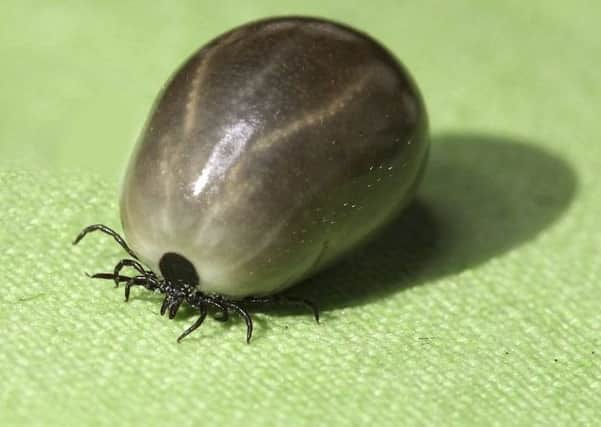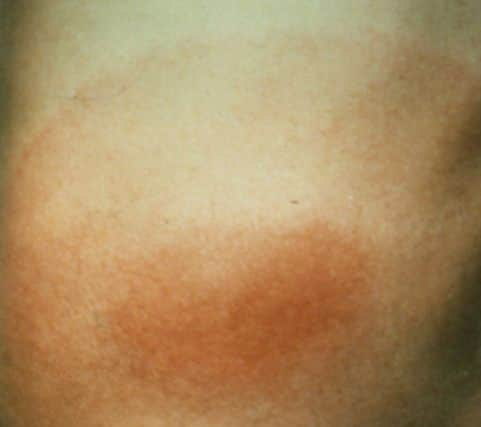Farmers and farm dogs at risk of lyme disease


Lyme disease is spread by ticks. Ticks are external parasites, related to spiders, that feed on the blood of the person or animal to which they are attached. Ticks can harbour the bacterium that causes Lyme disease in their saliva and transfer the infection when they are feeding.
In fact, ticks can spread various diseases to other farm animals too. Sheep develop Louping ill, which is spread by ticks, cattle can contract tick-borne fever or babesiosis, and even the poor farm cat is susceptible to tick-borne disease!
Advertisement
Advertisement
So where are ticks found? Ticks inhabit grass, hedgerows, bushes, woodlands and can even be found beside beaches. Areas foraged by deer are particularly prone to ticks. Hikers and walkers are often warned to wear long-sleeved tops, trousers and boots as any area of exposed skin, including the head, is a potential site of attachment for ticks. It is important that farmers adhere to this advice too. Ticks can attach anywhere on a dog’s body and have been found between the toes, attached to the nose or even inside the dog’s ear! They have also been found attached inside the mouth after dogs have eaten grass. It is often difficult to see them as ticks are clever at concealing themselves as it is in their interest not to be noticed!


Are ticks becoming more common? The moderate temperatures combined with high humidity of the recent Irish climate create the ideal environment for the development of the tick. While tick activity peaks anytime between spring through to autumn, these changes in temperatures and the mild winter just experienced mean that ticks are now becoming a year-round threat.
Ticks can be difficult to see with the naked eye when they first attach but become more obvious as they balloon with blood or “engorge” (Fig 1). They also have an anaesthetic agent in their saliva which means that they will not be felt attaching as the area of attachment is numbed. This is a clever way the tick has developed to avoid being brushed off before it gets the chance to feed. Some people will realise they have been bitten by a tick when they develop a bulls-eye type rash around the tick bite, but not all tick bites will result in these obvious signs (Fig.2). If you suspect that you have been bitten by a tick, then visit your doctor immediately as treatment to prevent Lyme disease progressing may be needed.
What are the clinical signs of Lyme disease? People with Lyme disease can experience a chronic debilitating weakness. Some people can have severe joint pain and others can even develop heart disease in the form of inflammation of the muscle wall of the heart. Lyme disease can be very difficult to diagnose as tests can be negative in a person suffering with the disease. Farm dogs can have an intermittent fever with no obvious reason for the elevated temperature. They can also go off their food and become weak and lethargic. Some dogs may develop stiffness and painful swollen joints. Any dog with these clinical signs should be brought to the vet immediately for assessment. Ticks in Ireland have also been found to carry a disease that causes fever, lethargy and lameness in cats.
Advertisement
Advertisement
Can anything be done to protect farm dogs and cats from tick borne disease? Limiting access to hedgerows and grass is not possible or practical in any working dog or farm cat.
Ticks are very difficult to remove as they are anchored heavily into the skin and pulling the tick out can result in a nasty infection or abscess at the site. Your veterinary practice will have special tick removers that are specifically designed to remove the anchored mouthpart of the tick, along with the tick itself. As ticks can be difficult to see when they first attach, the best way to protect these animals is to use a treatment that will kill ticks quickly when they attach so that they fall off easily of their own accord.
There are products in the form of a chew, spot-on or collar for dogs (spot-on or collars for cats), available from your vet, that will control ticks. Some of these products have the added advantage of also killing fleas as well as maintaining killing activity for a full 12 weeks and beyond. This makes year-round control of ticks and fleas possible. It is also makes it easier to remember to treat spring, summer, autumn and winter.
Ticks and tick-borne diseases are an ever-increasing threat to farmers and farm animals. Farmers can protect themselves by wearing clothing that will act as a barrier to tick bites. Farm dogs and cats can be protected by treating with a product that will quickly kill ticks and fleas for a full 12 weeks.